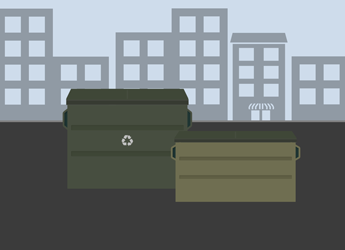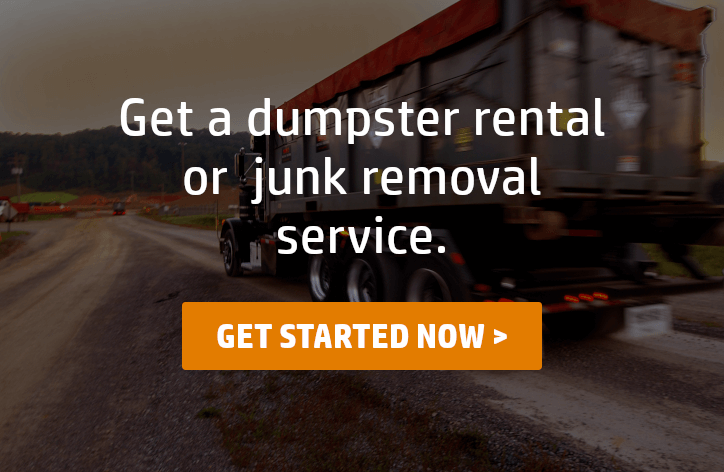Commercial Waste Disposal & Recycling
What is Commercial Waste?
Commercial or industrial waste is the solid, non-hazardous waste generated by commercial businesses such as restaurants, offices, stores, and other such establishments. The waste includes anything generated by the business itself, including gardening or lawn trimmings to maintain the premises, as well as the waste from its customers such as wrappers and plastic bags.
To dispose of this waste, the businesses must set up a collection schedule that differs from residential waste: for this type of waste, curbside collection in one green bin will not be adequate. Instead, businesses should buy or rent a dumpster and set up a collection schedule with their local waste management company.
Some waste facilities do not accept waste generated by businesses while some accept commercial waste at different rates than residential waste, so it is vital that the business owner or manager understands how to go about the disposal process.
American industrial facilities generate approximately seven and a half billion tons of solid waste each year, so it is imperative for each business to have a firm understanding of its waste procedures as well as what each business can do to decrease the amount of materials going to waste facilities.
Types of Commercial Dumpsters
While there are a wide variety of dumpsters available to rent or buy, the typical containers used by businesses are front and rear loading dumpsters.
Front Load Containers
Front loading dumpsters have a rear wall that is higher than the front wall, so the lid slopes upward and a person must lift the lid and toss the trash inside at the lower wall.
Rear Load Containers
Rear loading dumpsters have walls that are all the same height but one of the sides slants down towards the base; this shape allows the dumpsters to fit into awkward or tight-fitting spots that a front loading dumpster might not be able to.
Container Sizes
Both types of container typically come in two, four, six, eight, and ten cubic yards and can come with or without lids, though a dumpster on a commercial property will likely be legally required to have a lid.
The size of the dumpster depends on the business using it: a mom and pop antique shop that only has six or so customers a week could likely use the two yard dumpster, whereas a movie theater or big box store would look for something larger.
Choosing the Right Container
Deciding between using a front and rear loading dumpster depends on the business as well – rear dumpsters are more maneuverable, the shorter height allows for easier disposal, and often come on wheels while the front dumpsters are generally larger (making them ideal for larger businesses), made of steel or corrugated plastic to reduce the risk of fire or contamination, and can be divided into recycling and non-recycling sections.
Both dumpsters have the same rules about what people can throw in: food, trash, and anything nontoxic. If the manager is unsure about which dumpster to purchase, he would do well to call a dumpster company and speak with a representative about the business needs and the type of solution required. When purchasing a dumpster, it is also important to speak with the local permit office to learn what permits are needed for ownership of the container as well as where you can and cannot place the dumpster on the property.
Where Commercial Waste Goes
Thought it varies by location, commercial waste is generally collected by the private sector unlike residential waste, which is collected by the city. The business must make arrangements with a company to set up a collection schedule. The collection schedule, like the dumpster size, will vary depending on the business size – using the earlier examples, the antique shop might need weekly pickup while the big box store would likely need waste collection almost daily.
Again, if a business is unsure of their waste needs, they would do best to call a local waste management company to discuss their circumstances. The final destination of a business’ waste depends on the haulage company managing the dumpster pickup, but generally commercial debris ends up in a local waste facility where it is appropriately treated and processed.
Items That Should Not Be Disposed of in a Commercial Dumpster
While most waste is allowed inside a commercial trash dumpster, there are some items the Environmental Protection Agency (EPA) requests businesses dispose of through other means. If you are ever unsure whether or not an item is allowed to be thrown out in a regular dumpster, contact your local waste management office and a representative will point you in the right direction.
If you throw an item in a dumpster that is considered hazardous or not acceptable as mixed waste, you may face fines, criminal charges, or even a felony, depending on the item. Items that are not allowed to be put in dumpsters include hazardous waste, medical waste, chemical items, dirt, paint, anti-freeze, contaminated oils, solvents, pesticides, tires, microwaves, batteries, animals, liquids, barrels, tires, herbicides, household appliances, propane tanks, aerosol cans, televisions, railroad ties, and asbestos, among others. Additionally, never toss anything flammable, toxic or any other hazardous item into a dumpster.
Reasons for Disposal Restrictions
Commingling any of these items with regular waste can lead to environmental contamination, which in turn can bring about hazardous conditions for communities of people and the environment. When landfills are “full”, they are monitored until they have finished decomposing all of the material inside; when the decomposition process is complete, the landfill is turned over to the state and usually turned into parks or areas of wildlife. If any of the aforementioned items commingle with items allowed in a landfill, the landfill contamination would be devastating. It is vital that non-allowed items never be placed in a regular commercial trash container.
Instead of traveling to a landfill or recycling facility, some of these items – such as batteries – can be recycled (in a completely different manner than recycling normal household items such as plastic jugs and glass bottles), while others are incinerated. Still other items, such as toxic liquids, get mixed with cement for easier storage and are then stored in a storage facility as a toxic cement brick. Landfills specifically designed for toxic materials take on other materials – unlike normal waste landfills, these landfills are built with special safeguarding features in place, such as cement foundations, to prevent environmental contamination, and are often built in mines or caves.
Commercial Waste Recycling
Commercial waste recycling is not to be confused with commercial recycling; it is not the process we generally think of when we hear the term “recycling,” as in the above paragraph. Instead, commercial waste recycling is the reusing of the industrial scrap of the commercial business – generally, it does not include agricultural, chemical, or hazardous waste.
Consider an industrial factory that makes paper notebooks and ships them to stores such as Staples and OfficeMax. When the store opens the box, the notebooks are lined up perfectly in the box and within their own packages; have you ever thought of what happens to the excess materials that don’t fit in the box? These extra scraps are ideal for commercial waste recycling. Small scraps of paper, when added up over time from a factory, can result in tons of extra paper. Instead of throwing these small scraps away, the factory recycles them. The companies like Staples and OfficeMax can in turn easily recycle the cardboard boxes they receive shipments in as well as other plastic and wood packing materials. Construction waste can also fall into this category as wood, concrete, and bricks can often be reused.
Because the waste stream from commercial waste tends to be cleaner, it is often easier to recycle than residential waste. Consider the following: household recycling tends to go into one bin and is full of recyclables that need to be sorted such as shampoo bottles, glass jars, cardboard boxes, newspapers, and more. Sometimes non-recyclable materials are tossed in there as well, contaminating the entire bin. As of now, there is no mechanical way to sort the recyclables, so it must all be done by hand at a facility.
When a business recycles its waste, on the other hand, it is often in large quantities of similar material. For example, Staples can easily recycle one huge batch of cardboard boxes from the paper shipment it received earlier as well as a separate batch of the wooden platforms it was shipped on. Both loads are separated and consist of entirely one material, making it easier to recycle. It makes sense for the business to partake in commercial waste recycling instead of the typical recycling process that mixes its operational recyclable items with its customers’ recyclable items.


